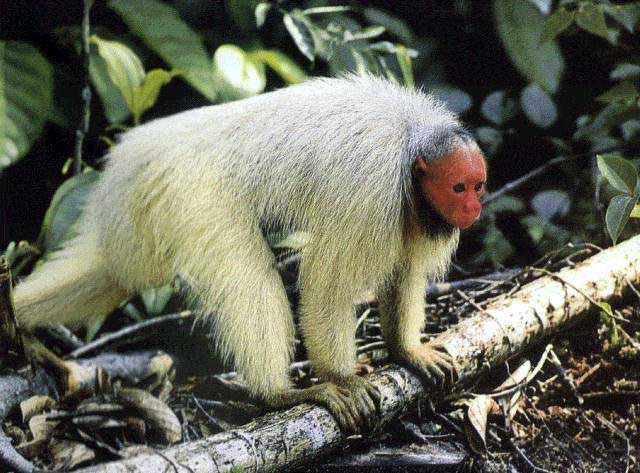The red uakari (Cacajao calvus rubicundus) is a species of New World monkey found in the river Amazon. These monkeys are classified as vulnerable by the IUCN due to habitat destruction and hunting. They are currently protected by law in few places.
Physical Features
One of the most attracting feature about this monkey is its bald and bright red face. The red uakari is a relatively small monkey, measuring about 57 cm (22.5 inches). These monkey weigh 2 to 3 kilograms. Red uakaris have ragged and long body coats that varies from reddish-brown to orange. Unlike other monkeys, red uakaris have very short tails. Red uakaris have bright red faces due to lack of skin pigments and also because of the plentiful capillaries that run under their facial tissue.
Diet
 |
| Red uakari feeding. |
Life Cycle
Females give birth to a single young every two years after a gestation period of 6 months. The young is weaned at 20 months. Females uakaris mature at the age of 3 while males mature at the age of 5. Red uakaris may live for 30 years in captivity and 10 years in wild.
Distribution and Habitat
Red uakaris are found in the Amazon Basin of South America. They are found in the upper part of the Amazon which is in eastern Peru and southern Colombia. They like to live in the flooded forests of this river. Red uakaris will mainly be found in places where there are small lakes or rivers nearby.
Behavior
The red uakari is mainly tree dwelling but often descends to the ground. They live in social groups of 15 to 30 individuals or sometimes even 100. These social groups travel 4.8 kilometers a day. They are mainly active during the day. Red uakaris are normally silent but while fighting, they are very noisy.
Population
The red uakari is rated as vulnerable by the IUCN. It might have population of several thousands. 3 subspecies are considered to be endangered and 1 subspecies is considered to be vulnerable. Red uakaris are mainly endangered due to forest clearance.
Source of picture 1:http://mortonloveseverybody.blogspot.com/2007_04_01_archive.html
Source of picture 2:http://www.natgeocreative.com/ngs/photography/gallery.jsf?l=gKXR3FwT9Ao=outm_source=Gmaputm_medium=Gmaputm_campaign=Gmap

No comments:
Post a Comment